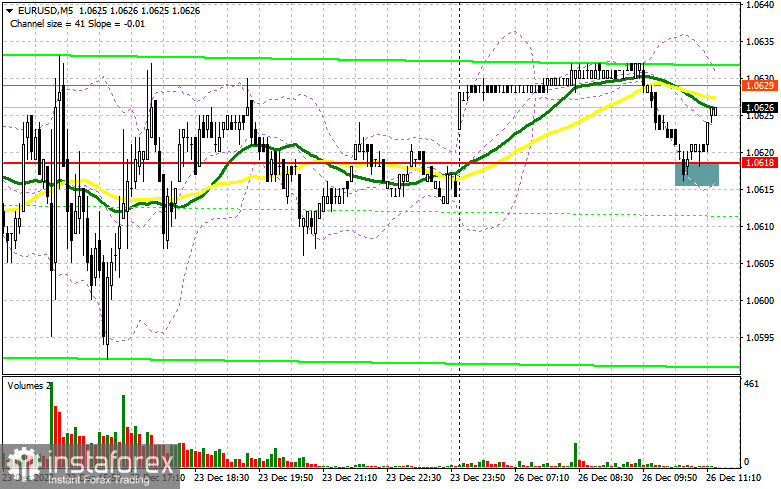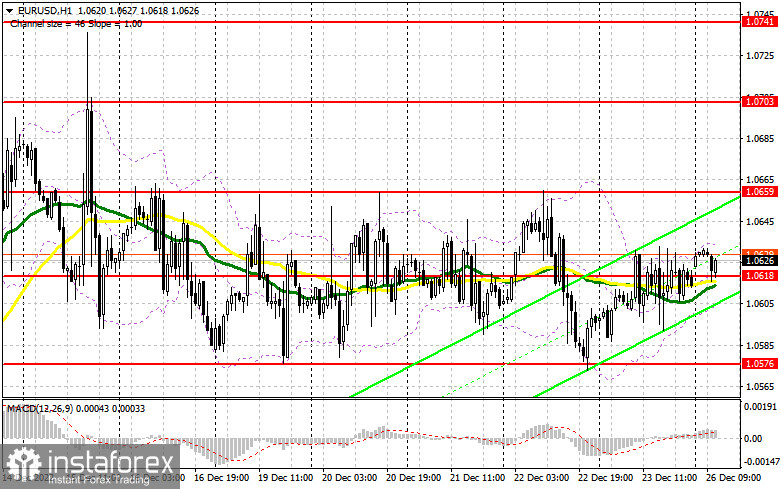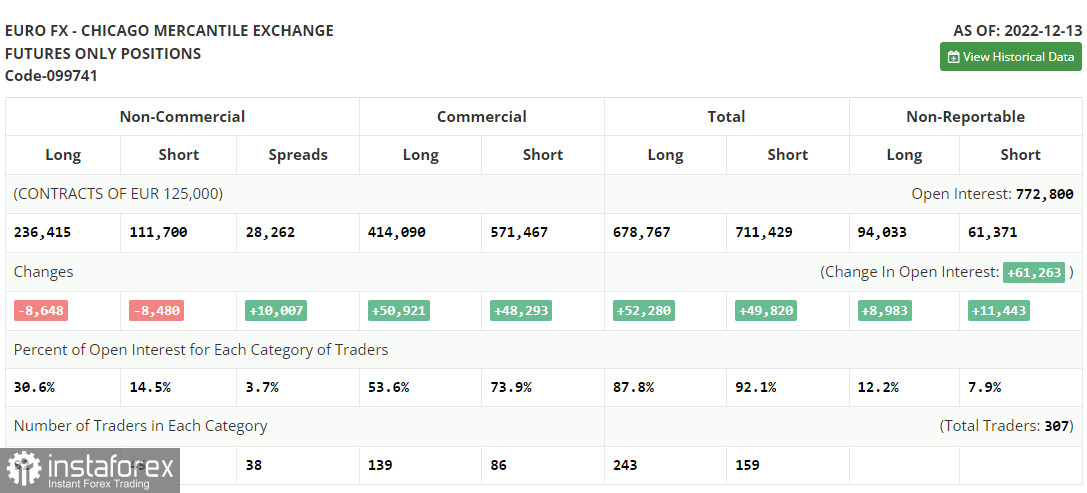In the morning article, I turned your attention to 1.0618 and recommended making decisions with this level in focus. Let's look at the 5-minute chart and figure out what actually happened. A decline and a false breakout of 1.0618 generated an excellent buy signal. It remains relevant at the time of writing the article. The pair went up by only 10 pips because of low volatility and trading volumes. For the afternoon, the technical outlook has not been revised.

When to open long positions on EUR/USD:
Trading floors in the US are closed on the occasion of the Christmas holidays. This is why there could hardy by any sharp price swings. It is better to open long positions after a drop and a false breakout of 1.0618, which acts as the middle sideways channel. At this level, the moving averages are passing. It will give an entry point into long positions. The pair is likely to reach 1.0659. However, this level might limit the further upward movement of the pair. A breakout and a downward retest of this level will create an additional entry point in long positions with the prospect of a jump to a high of 1.0703. A breakout of this level will also force bears to close Stop Loss orders and give an additional buy signal. The pair could grow to 1.0741. The test of this level will initiate the formation of an uptrend at the end of the year. I recommend locking in profits there. If EUR/USD declines and bulls show no activity at 1.0618 in the afternoon, the pressure on the pair will increase. In this case, sellers are likely to regain the upper hand. The pair may decrease to 1.0576. I would advise you to open long positions there only if a false breakout takes place. You could buy EUR/USD immediately t a bounce from 1.0535 or lower at 1.0495, keeping in mind an upward intraday correction of 30-35 pips.
When to open short positions on EUR/USD:
Sellers will probably enter the market only after the test of the nearest resistance level of 1.0659. It is rather crucial for them to defend this level. As the US economic calendar remains empty, it will certainly limit the upward potential of the pair. So, there is a high chance of a false breakout. For this reason, it is better to open short positions if bulls fail to push the pair above 1.0659. If so, the pair may drop to 1.0618 – the middle of the sideways channel. A breakout and an upward retest of this level will escalate pressure on the euro, creating an additional sell signal with a correction to 1.0576. The bears could exit the market at this level. A drop below this level will trigger a drastic fall to 1.0535. In this case, bears could cement the downward movement for the euro at the end of the year. A more distant target will be the 1.0495 level where I recommend locking in profits. If EUR/USD rises during the American session and bears show no energy at 1.0659, it will hardly change the market sentiment. I would advise you to postpone short positions until a breakout of the upper limit of the sideways channel located at 1.0703. It is better to open short positions there only after an unsuccessful attempt to consolidate above this level. You could sell EUR/USD immediately at a bounce from a high of 1.0741, keeping in mind a downward intraday correction of 30-35 pips.

COT report
According to the COT report from December 13, the number of both long and short positions dropped. Most traders decided to lock in profits before the meetings of the global central banks, which were held last week. This, in turn, led to a decline in the volume of positions. It is obvious that the hawkish policy chosen by the Fed and the ECB will continue to affect the growth of risk assets. The fact is that the intention of the central banks to combat inflation may lead to a recession in both the US and Europe. The COT report unveiled that the number of long non-commercial positions decreased by 8,648 to 236,415, whereas the number of short non-commercial positions dropped by 8,480 to 111, 700. At the end of the week, the total non-commercial net position became slightly smaller and amounted to 122,247 against 123,113. This indicates that investors remain balanced. Although they avoid buying the euro at the moment, they are not in a hurry to sell risky assets even at the current prices. A new fundamental reason is needed for further growth in the euro. The weekly closing price rose to 1.0342 from 1.0315.

Indicators' signals:
Trading is carried out near the 30 and 50 daily moving averages. It indicates that the pair is moving in the sideways channel.
Moving averages
Note: The period and prices of moving averages are considered by the author on the H1 (1-hour) chart and differ from the general definition of the classic daily moving averages on the daily D1 chart.
Bollinger Bands
If EUR/USD rises, the indicator's upper border at 1.0635 will serve as resistance.
Description of indicators
- Moving average (moving average, determines the current trend by smoothing out volatility and noise). Period 50. It is marked yellow on the chart.
- Moving average (moving average, determines the current trend by smoothing out volatility and noise). Period 30. It is marked green on the chart.
- MACD indicator (Moving Average Convergence/Divergence - convergence/divergence of moving averages) Quick EMA period 12. Slow EMA period to 26. SMA period 9
- Bollinger Bands (Bollinger Bands). Period 20
- Non-commercial speculative traders, such as individual traders, hedge funds, and large institutions that use the futures market for speculative purposes and meet certain requirements.
- Long non-commercial positions represent the total long open position of non-commercial traders.
- Short non-commercial positions represent the total short open position of non-commercial traders.
- Total non-commercial net position is the difference between the short and long positions of non-commercial traders.
 English
English 
 Русский
Русский Bahasa Indonesia
Bahasa Indonesia Bahasa Malay
Bahasa Malay ไทย
ไทย Español
Español Deutsch
Deutsch Български
Български Français
Français Tiếng Việt
Tiếng Việt 中文
中文 বাংলা
বাংলা हिन्दी
हिन्दी Čeština
Čeština Українська
Українська Română
Română

